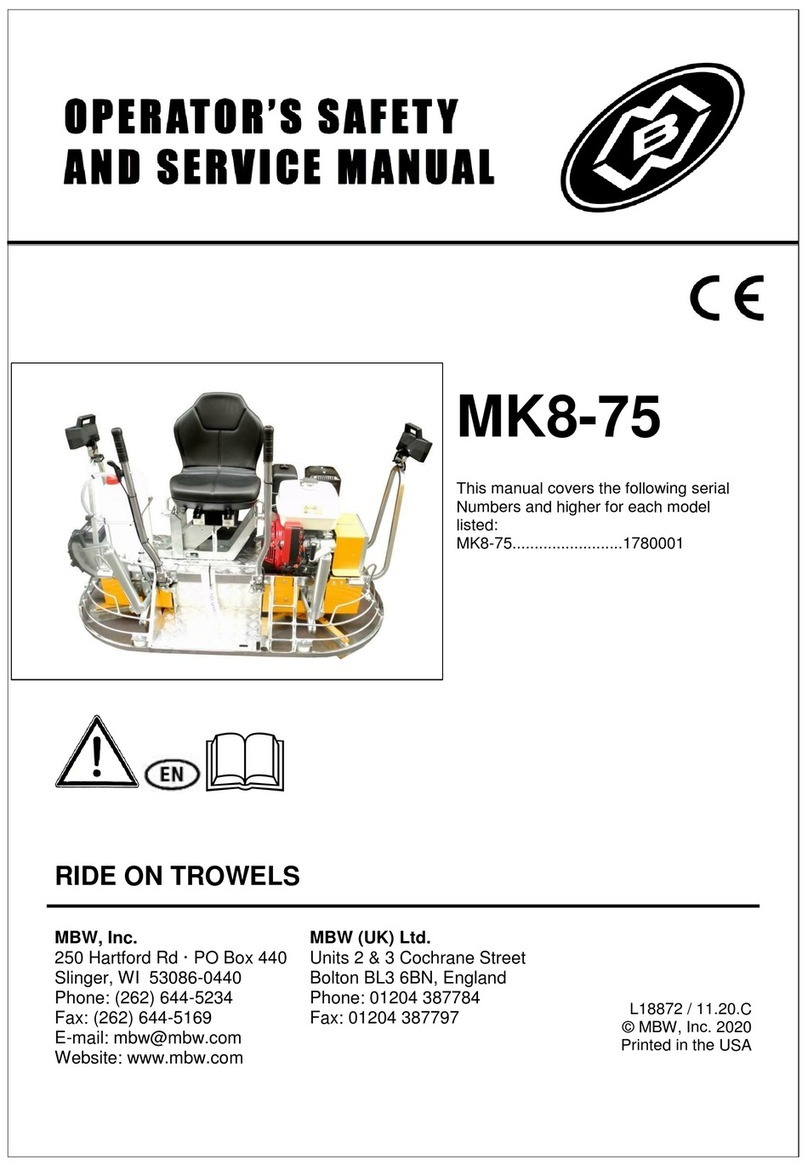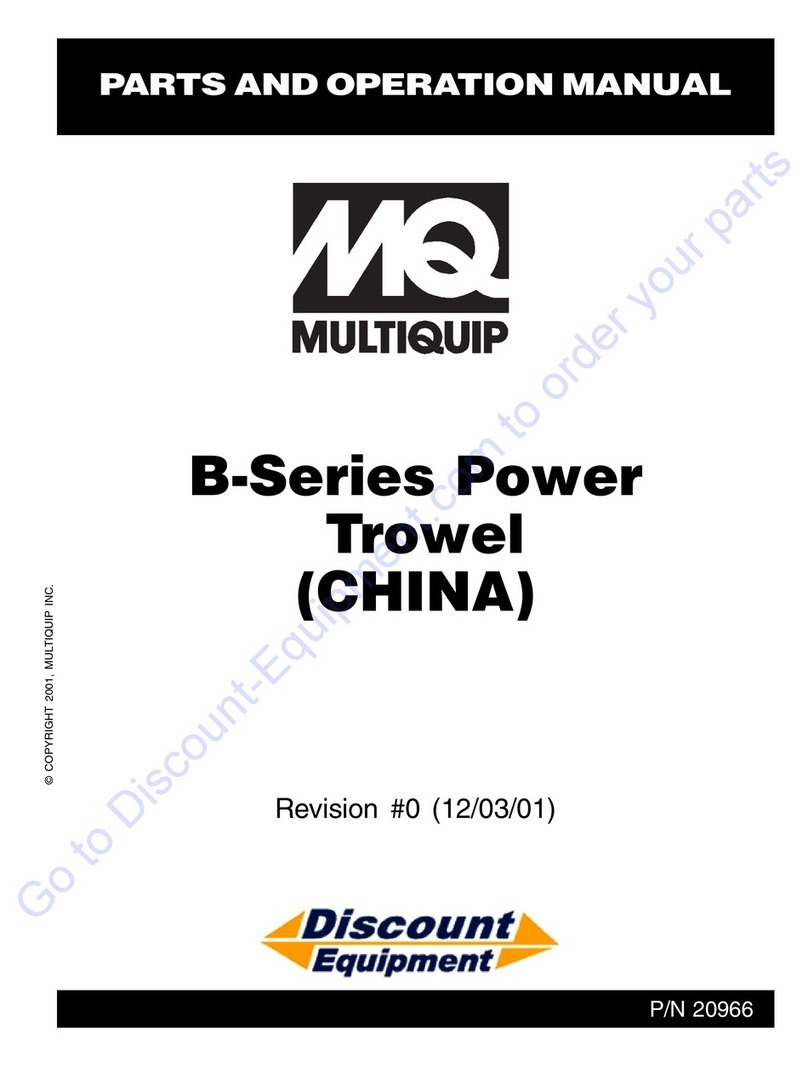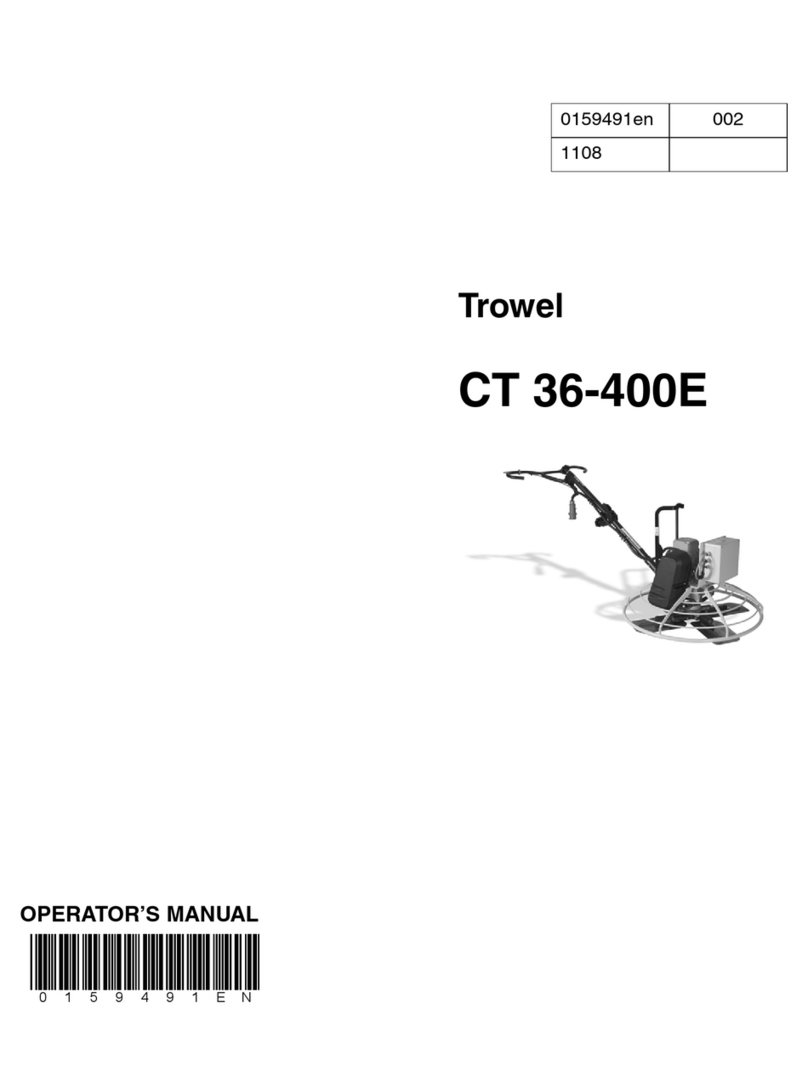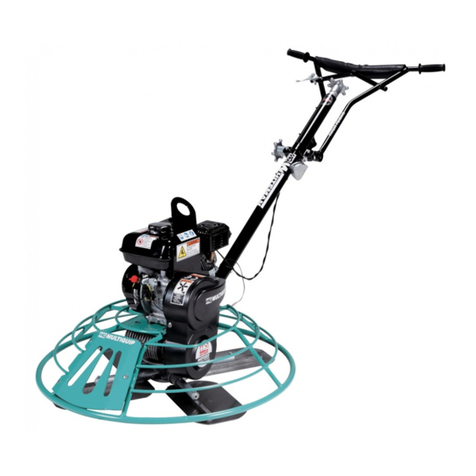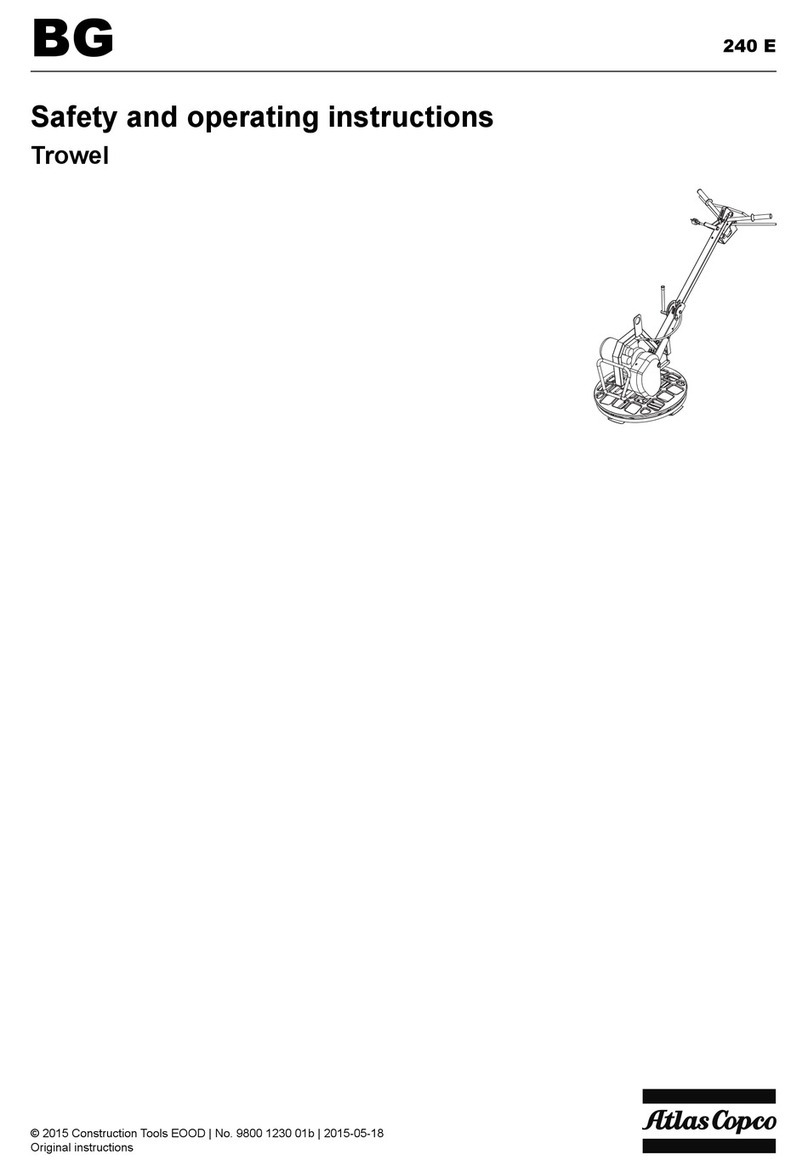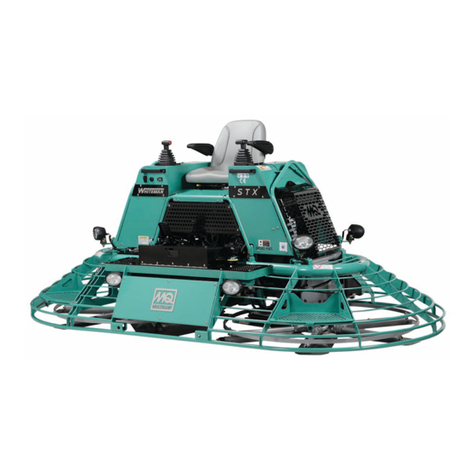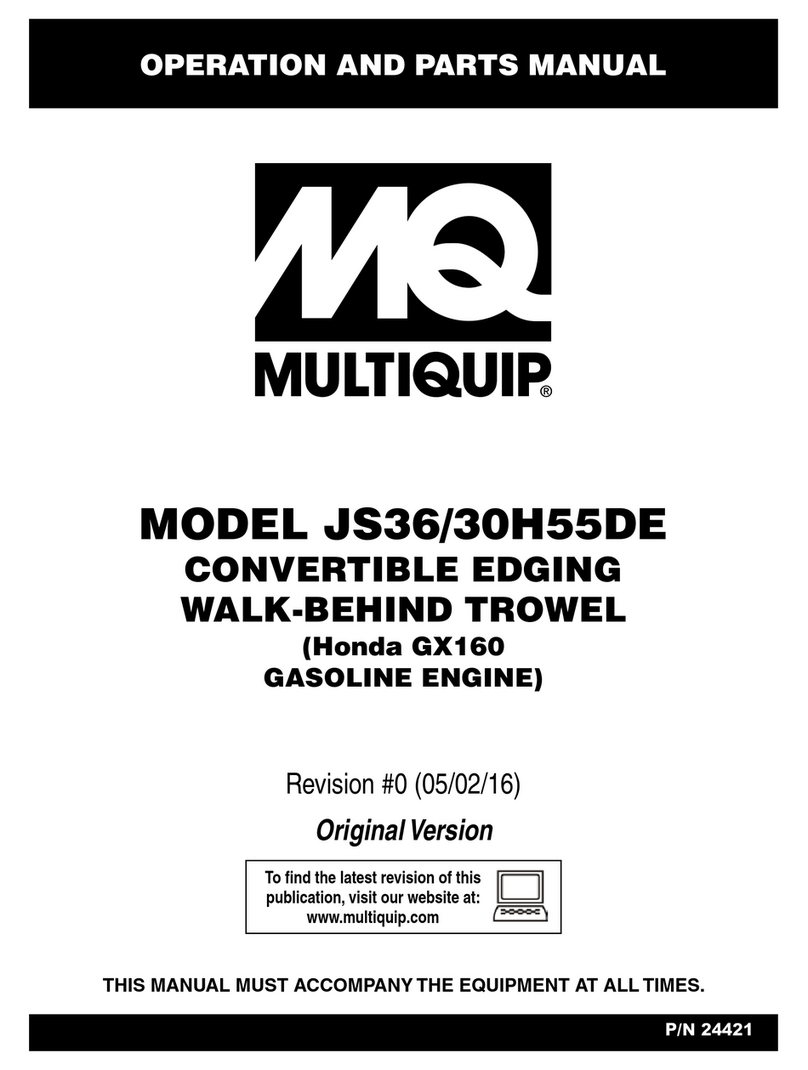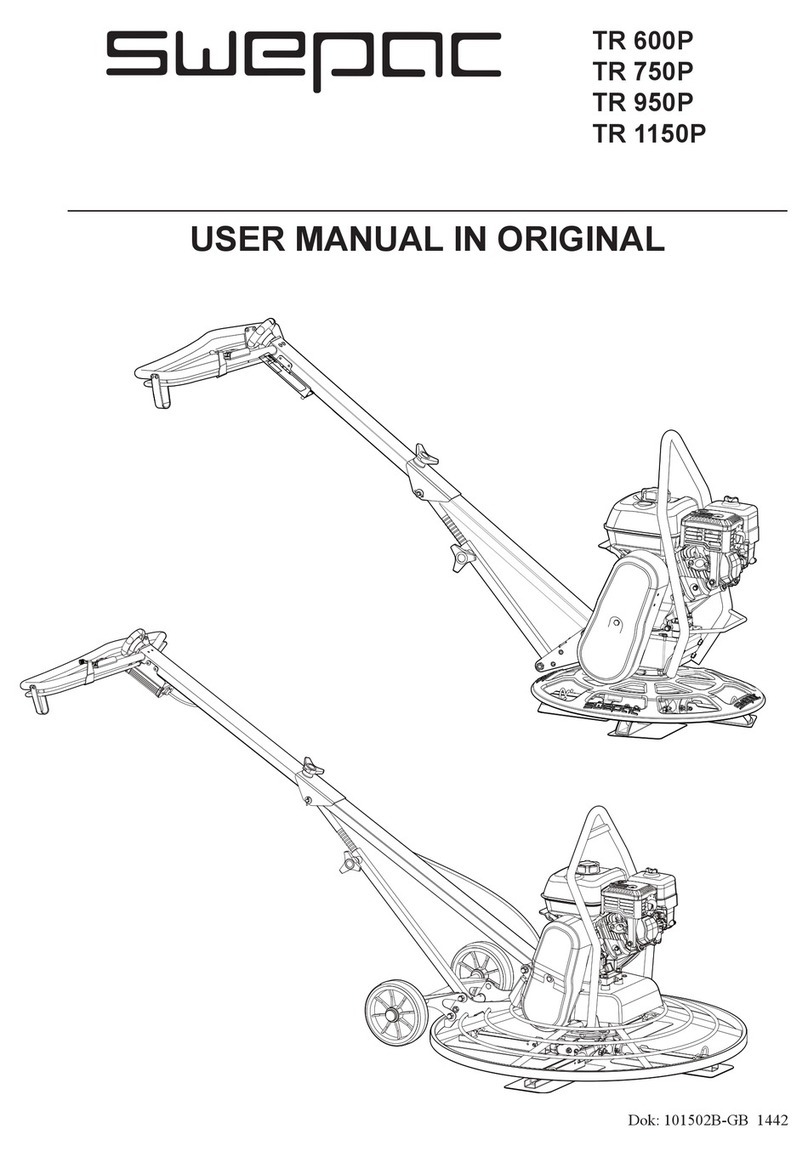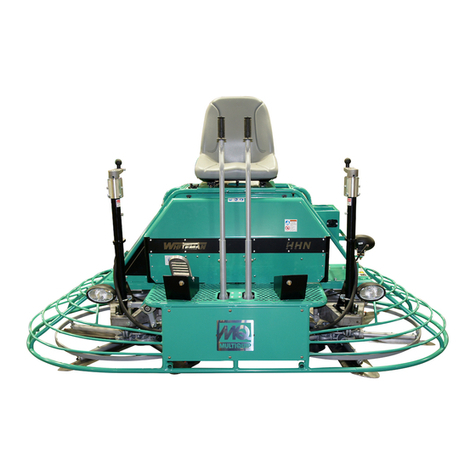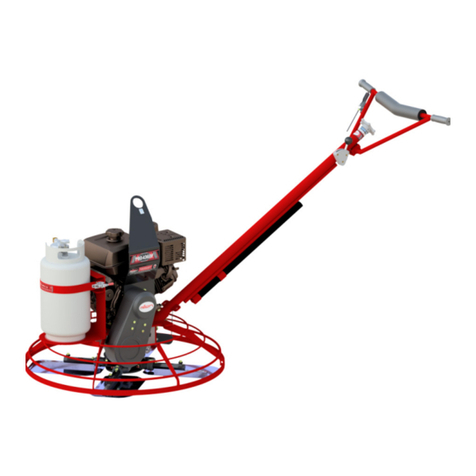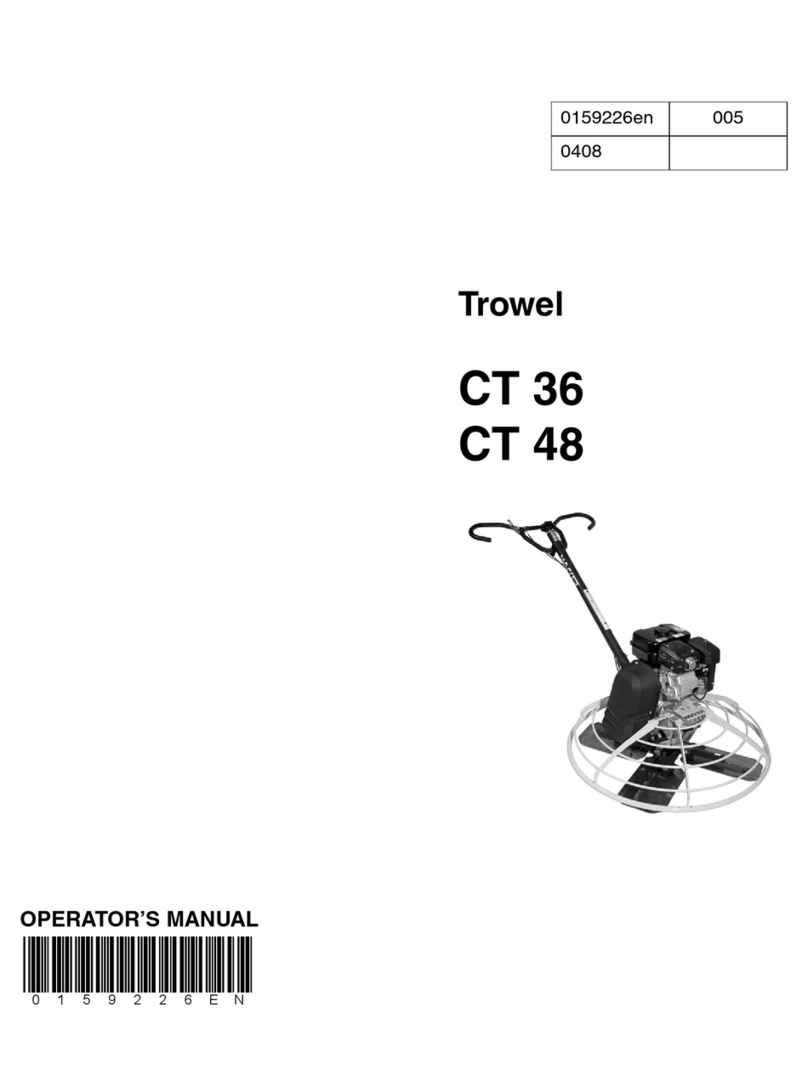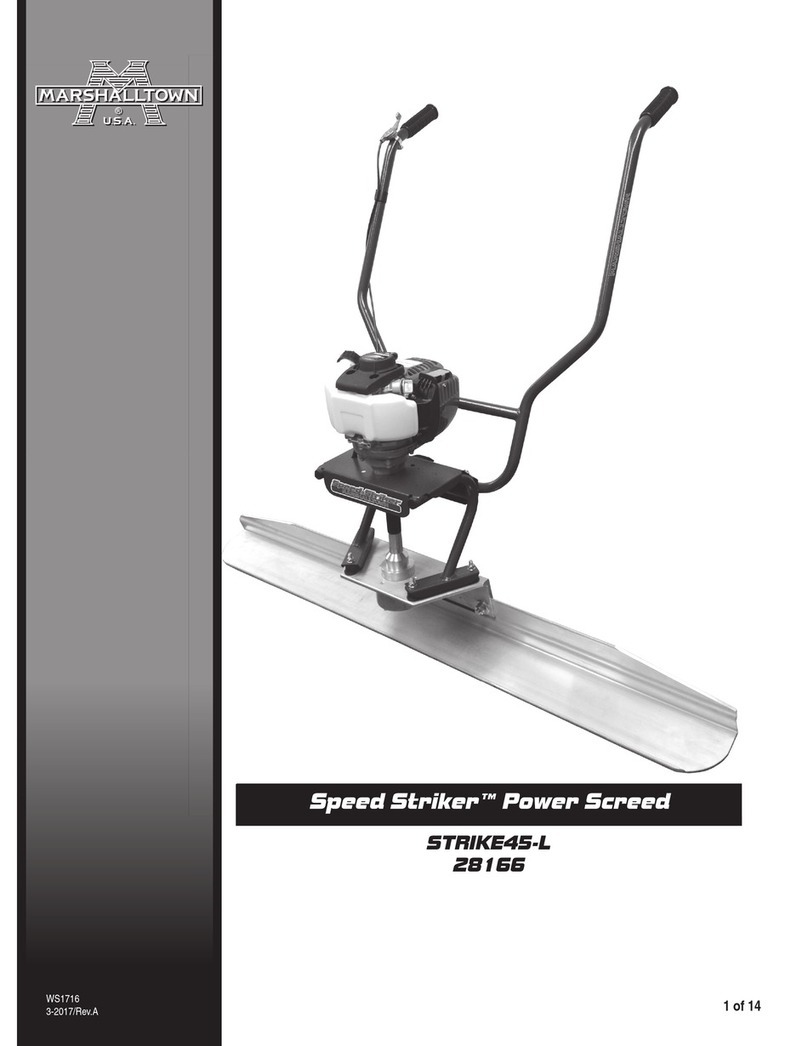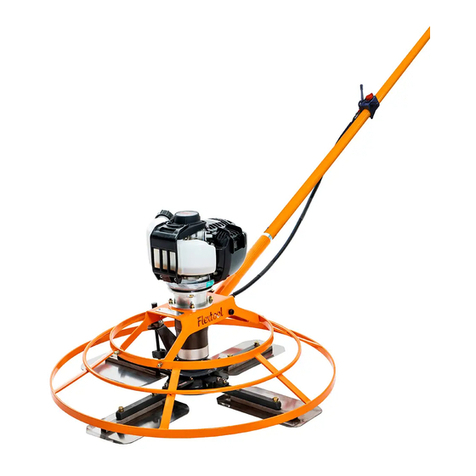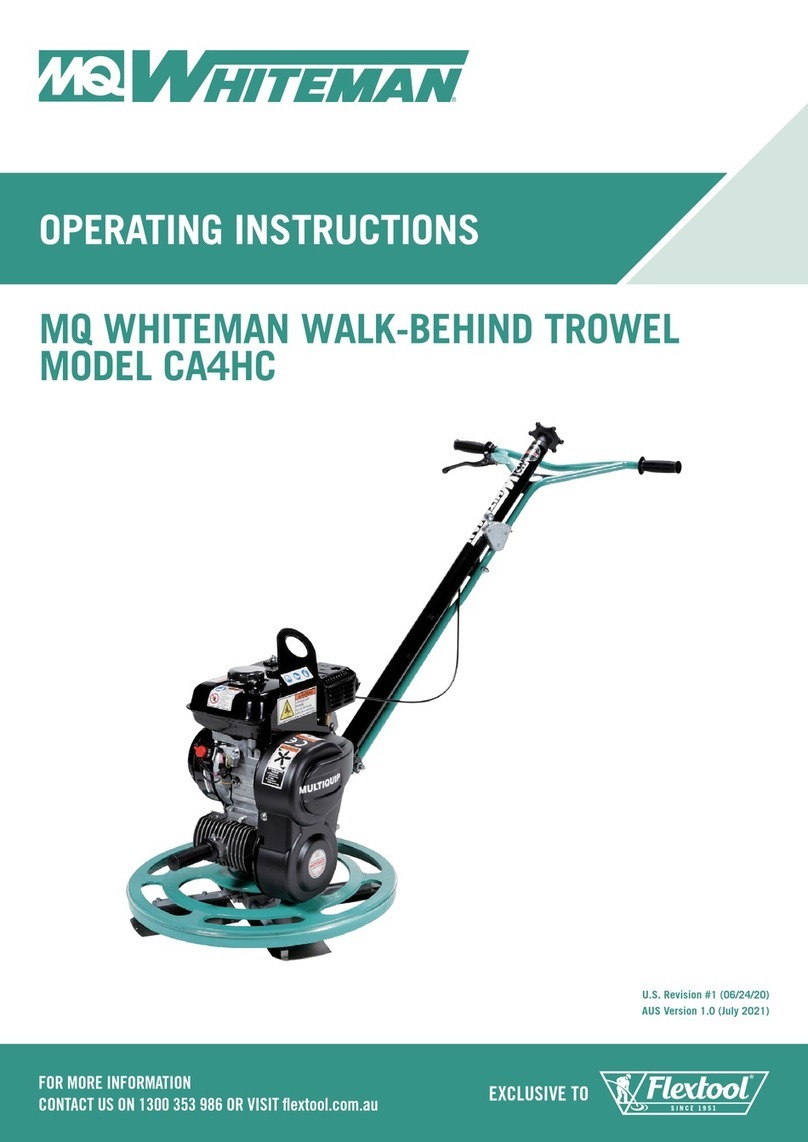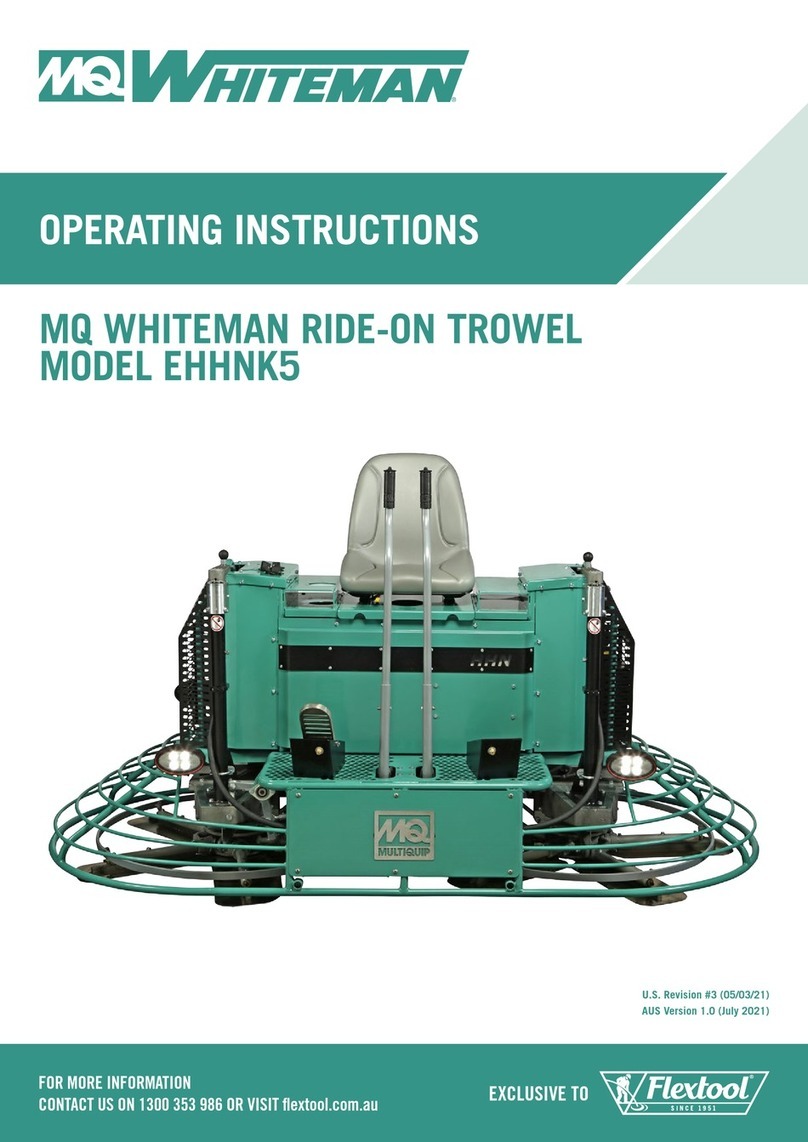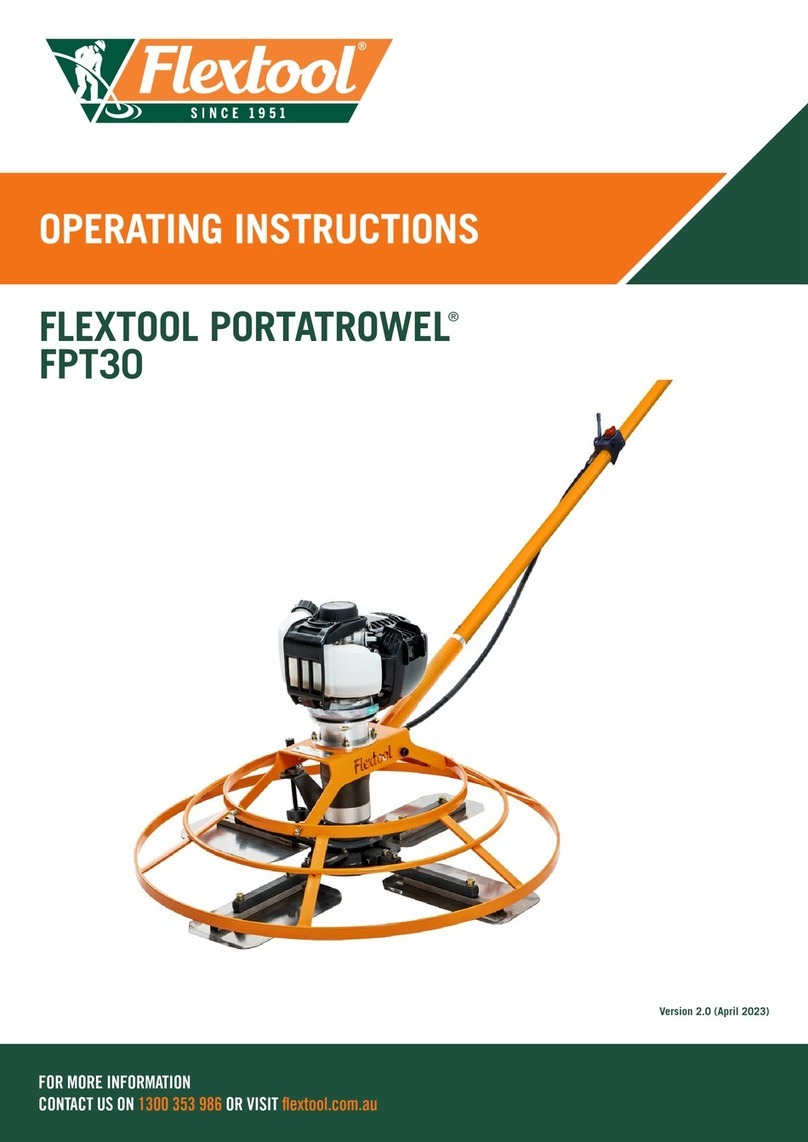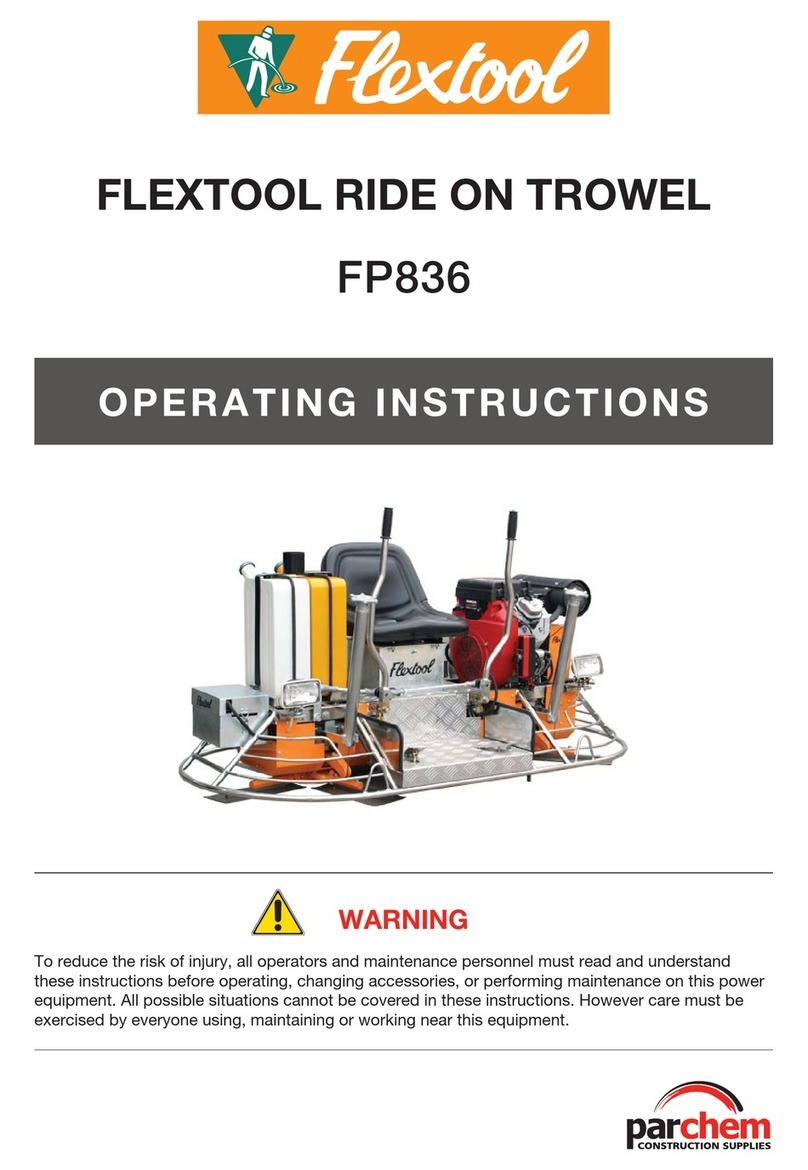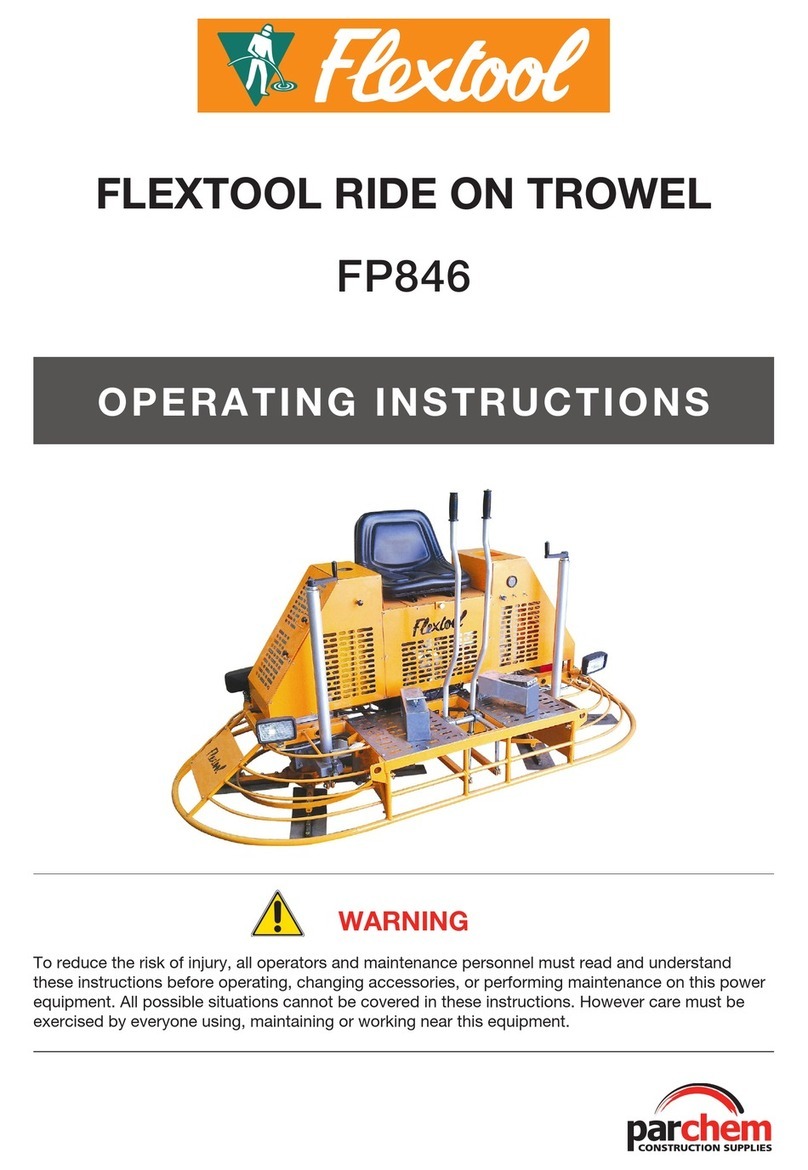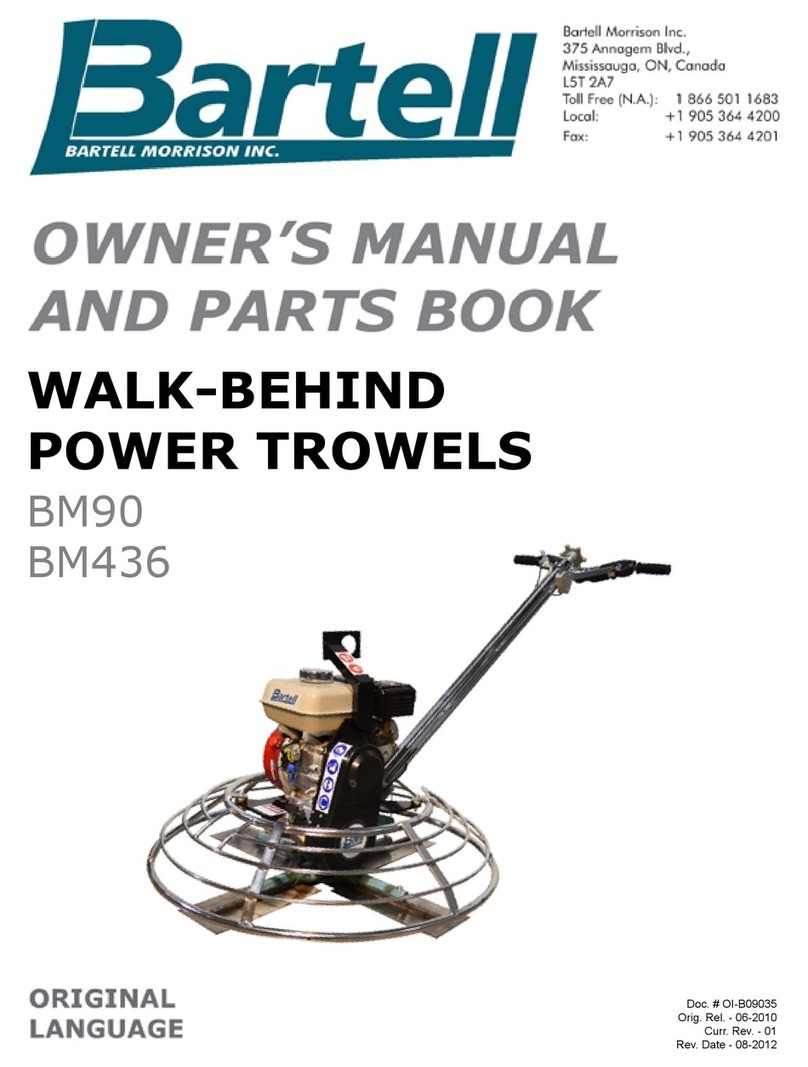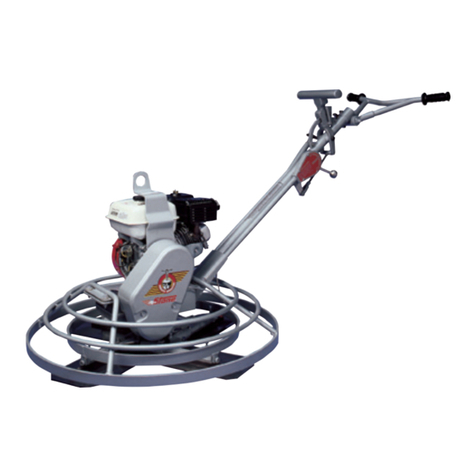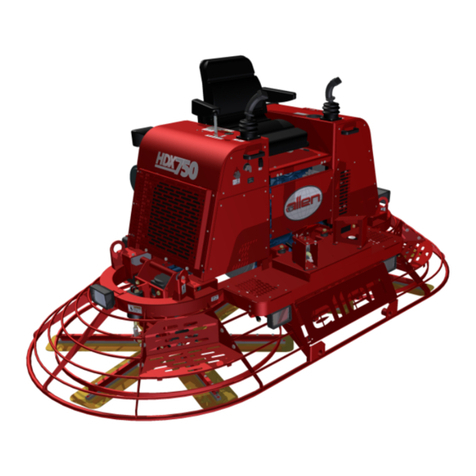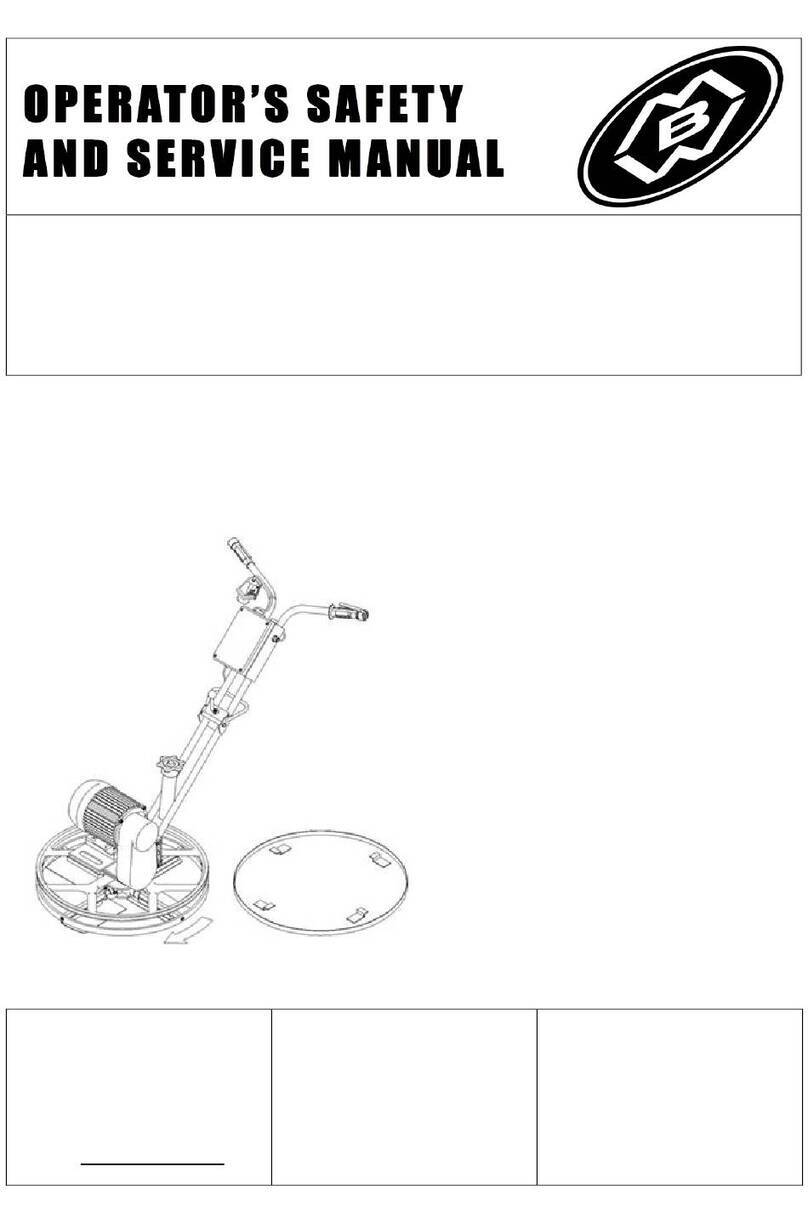
FLEXTOOL OPERATING INSTRUCTIONS FLEXTOOL PROFINISH RIDE-ON POWER TROWEL SERIES
4
flextool.com.au
OPERATION
INSPECTION
The following items should be checked on a daily basis before
operating the trowel.
• Engine oil level
• Gearbox oil level
• Blade condition and pitch control operation
• V-belt clutch operation
• Safety Stop Switch operation
ENGINE OPERATION
1. Move the engine Fuel Valve Lever to “ON” position.
2. Move the Safety Stop Switch to “ON” position or hold safety
switch pedal down with foot.
3. Place the Choke Lever in the “CLOSED” position.
4. Rotate the Ignition key to Start the Engine – Electric start
feature.
5. If the engine has started, return the Choke Lever to “OPEN”
position; If the engine has not started, repeat 1 to 5 steps
above.
6. Run the engine for a few minutes and make sure the machine is
in normal working condition.
7. Test the Safety Stop Switch or safety switch pedal. This test
should be conducted in a clear area. Remove left foot from the
‘safety switch pedal’, with the engine at idle. The engine should
shut down.
8. DO NOT TAPE UP, TAMPER WITH OR DISABLE THESE
SAFETY DEVICES
9. To start trowelling, gradually push down on the foot pedal to
achieve the desired blades speed specic to concrete surface
conditions.
MACHINE OPERATION
Steering the machine on a slab is relatively simple but does require
some practice prior to actually working with the machine.
The illustration shows the necessary hand movements required to
move the trowel in the desired direction.
For straight line movements (forward and reverse) move the
handles in the same direction you wish to travel.
Move the handles in the opposite directions to produce rotation on
the machine axis.
Left handle forward, right handle backwards for clockwise
direction.
Left handle backwards, right handle forward for the
counter-clockwise direction.
Sideways direction is achieved by moving the right handle either
the left or right direction.
To familiarize a new operator with the ride-on trowel the following
steps should be taken:
• With the operator seated on the machine prior to starting
the unit show them the function of the ignition switch, safety
switch pedal, throttle control, steering handles, and blade tilt
levers. Prior to starting the unit, ensure the operator knows the
emergency stop procedure. To stop the unit the operator can
either release pressure from the safety switch pedal or release
the throttle control.
• Once the operator is familiar with these controls, they need to
practice steering the trowel. The best place for this is on a large
section of nished concrete which is at ground level.
• With the blades in the at position have the operator depress
the safety switch pedal and start the unit without depressing
the throttle control. With both hands on the steering handles the
operator should depress the throttle control to about halfway and
obtain a feeling for the steering by making the machine hover in
the one spot.
• Once the operator feels condent and is able to make small
steering inputs to maintain the position of the unit, they may then
practice riding the machine in a straight line and making 180
degree turns. This is best done at full throttle as the machine is
easiest to control at full rpm.
• The operator should continue to practice operating the unit until
they are familiar with the steering and operation of the unit. The
operator should not start working with the machine until they are
capable of being in complete control of the machine and their
actions while operating the machine.
1 - forward
2 - reverse
3 - rotate clockwise
4 - rotate counter-clockwise
5 - left sideways
6 - right sideways
FLEXTOOL OPERATING INSTRUCTIONS
FLEXTOOL PROFINISH RIDE ON TROWELS
1300 353 986
flextool.com.au
MACHINE OPERATION
Steering the machine on a slab is relatively simple but does require some practice prior to actually working with the
machine.
The illustration shows the necessary hand movements required to move the trowel in the desired direction.
For straight line movements (forward and reverse) move the handles in the same direction you wish to travel.
Move the handles in the opposite directions to produce rotation on the machine axis.
Left handle forward, right handle backwards for clockwise direction.
Left handle backwards, right handle forward for the counterclockwise direction.
Sideways direction is achieved by moving the right handle either the left or right direction.
To familiarize a new operator with the ride-on trowel the following steps should be taken:
• With the operator seated on the machine prior to starting the unit show them the function of the ignition switch,
safety switch pedal, throttle control, steering handles, and blade tilt levers. Prior to starting the unit, ensure the
operator knows the emergency stop procedure. To stop the unit the operator can either release pressure from
the safety switch pedal or release the throttle control.
• Once the operator is familiar with these controls, they need to practice steering the trowel. The best place for
this is on a large section of finished concrete which is at ground level.
• With the blades in the flat position have the operator depress the safety switch pedal and start the unit without
depressing the throttle control. With both hands on the steering handles the operator should depress the throttle
control to about halfway and obtain a feeling for the steering by making the machine hover in the one spot.
• Once the operator feels confident and is able to make small steering inputs to maintain the position of the unit,
they may then practice riding the machine in a straight line and making 180 degree turns. This is best done at
full throttle as the machine is easiest to control at full RPM.
• The operator should continue to practice operating the unit until they are familiar with the steering and operation
of the unit. The operator should not start working with the machine until they are capable of being in complete
control of the machine and their actions while operating the machine.
CARE AND PREVENTIVE MAINTENANCE
ENSURE repairs and maintenance of the trowel machine is performed only by qualified personnel.
CAUTION: Make sure the engine is shut down, isolated and cool enough before performing repairs and maintenance.
For preventive maintenance of the engine, please refer to the Owner’s Manual of the engine fitted supplied with the Ride
on Power trowel. The following schedule should be followed when performing regular maintenance of the trowel:
DAILY (8 – 10 HOURS)
• Check the oil level in the engine crankcase and gearbox before each use, refill as necessary. The gearbox is
fitted with a sight glass, maintain the oil level at the halfway level on the sight glass.
• Check that the V-belt is running true. Adjust or replace as necessary.
• Keep the trowel clean and free of concrete residue after each use.
WEEKLY (50 – 60 HOURS)
• Check and clean or replace engine air filter as necessary.
• Check blades for their condition and adjust or replace if necessary.
• Relubricate trowel arms and thrust collars.
FLEXTOOL OPERATING INSTRUCTIONS
FLEXTOOL PROFINISH RIDE ON TROWELS
1300 353 986
flextool.com.au
MACHINE OPERATION
Steering the machine on a slab is relatively simple but does require some practice prior to actually working with the
machine.
The illustration shows the necessary hand movements required to move the trowel in the desired direction.
For straight line movements (forward and reverse) move the handles in the same direction you wish to travel.
Move the handles in the opposite directions to produce rotation on the machine axis.
Left handle forward, right handle backwards for clockwise direction.
Left handle backwards, right handle forward for the counterclockwise direction.
Sideways direction is achieved by moving the right handle either the left or right direction.
To familiarize a new operator with the ride-on trowel the following steps should be taken:
• With the operator seated on the machine prior to starting the unit show them the function of the ignition switch,
safety switch pedal, throttle control, steering handles, and blade tilt levers. Prior to starting the unit, ensure the
operator knows the emergency stop procedure. To stop the unit the operator can either release pressure from
the safety switch pedal or release the throttle control.
• Once the operator is familiar with these controls, they need to practice steering the trowel. The best place for
this is on a large section of finished concrete which is at ground level.
• With the blades in the flat position have the operator depress the safety switch pedal and start the unit without
depressing the throttle control. With both hands on the steering handles the operator should depress the throttle
control to about halfway and obtain a feeling for the steering by making the machine hover in the one spot.
• Once the operator feels confident and is able to make small steering inputs to maintain the position of the unit,
they may then practice riding the machine in a straight line and making 180 degree turns. This is best done at
full throttle as the machine is easiest to control at full RPM.
• The operator should continue to practice operating the unit until they are familiar with the steering and operation
of the unit. The operator should not start working with the machine until they are capable of being in complete
control of the machine and their actions while operating the machine.
CARE AND PREVENTIVE MAINTENANCE
ENSURE repairs and maintenance of the trowel machine is performed only by qualified personnel.
CAUTION: Make sure the engine is shut down, isolated and cool enough before performing repairs and maintenance.
For preventive maintenance of the engine, please refer to the Owner’s Manual of the engine fitted supplied with the Ride
on Power trowel. The following schedule should be followed when performing regular maintenance of the trowel:
DAILY (8 – 10 HOURS)
• Check the oil level in the engine crankcase and gearbox before each use, refill as necessary. The gearbox is
fitted with a sight glass, maintain the oil level at the halfway level on the sight glass.
• Check that the V-belt is running true. Adjust or replace as necessary.
• Keep the trowel clean and free of concrete residue after each use.
WEEKLY (50 – 60 HOURS)
• Check and clean or replace engine air filter as necessary.
• Check blades for their condition and adjust or replace if necessary.
• Relubricate trowel arms and thrust collars.
FLEXTOOL OPERATING INSTRUCTIONS
FLEXTOOL PROFINISH RIDE ON TROWELS
1300 353 986
flextool.com.au
MACHINE OPERATION
Steering the machine on a slab is relatively simple but does require some practice prior to actually working with the
machine.
The illustration shows the necessary hand movements required to move the trowel in the desired direction.
For straight line movements (forward and reverse) move the handles in the same direction you wish to travel.
Move the handles in the opposite directions to produce rotation on the machine axis.
Left handle forward, right handle backwards for clockwise direction.
Left handle backwards, right handle forward for the counterclockwise direction.
Sideways direction is achieved by moving the right handle either the left or right direction.
To familiarize a new operator with the ride-on trowel the following steps should be taken:
• With the operator seated on the machine prior to starting the unit show them the function of the ignition switch,
safety switch pedal, throttle control, steering handles, and blade tilt levers. Prior to starting the unit, ensure the
operator knows the emergency stop procedure. To stop the unit the operator can either release pressure from
the safety switch pedal or release the throttle control.
• Once the operator is familiar with these controls, they need to practice steering the trowel. The best place for
this is on a large section of finished concrete which is at ground level.
• With the blades in the flat position have the operator depress the safety switch pedal and start the unit without
depressing the throttle control. With both hands on the steering handles the operator should depress the throttle
control to about halfway and obtain a feeling for the steering by making the machine hover in the one spot.
• Once the operator feels confident and is able to make small steering inputs to maintain the position of the unit,
they may then practice riding the machine in a straight line and making 180 degree turns. This is best done at
full throttle as the machine is easiest to control at full RPM.
• The operator should continue to practice operating the unit until they are familiar with the steering and operation
of the unit. The operator should not start working with the machine until they are capable of being in complete
control of the machine and their actions while operating the machine.
CARE AND PREVENTIVE MAINTENANCE
ENSURE repairs and maintenance of the trowel machine is performed only by qualified personnel.
CAUTION: Make sure the engine is shut down, isolated and cool enough before performing repairs and maintenance.
For preventive maintenance of the engine, please refer to the Owner’s Manual of the engine fitted supplied with the Ride
on Power trowel. The following schedule should be followed when performing regular maintenance of the trowel:
DAILY (8 – 10 HOURS)
• Check the oil level in the engine crankcase and gearbox before each use, refill as necessary. The gearbox is
fitted with a sight glass, maintain the oil level at the halfway level on the sight glass.
• Check that the V-belt is running true. Adjust or replace as necessary.
• Keep the trowel clean and free of concrete residue after each use.
WEEKLY (50 – 60 HOURS)
• Check and clean or replace engine air filter as necessary.
• Check blades for their condition and adjust or replace if necessary.
• Relubricate trowel arms and thrust collars.
FLEXTOOL OPERATING INSTRUCTIONS
FLEXTOOL PROFINISH RIDE ON TROWELS
1300 353 986
flextool.com.au
MACHINE OPERATION
Steering the machine on a slab is relatively simple but does require some practice prior to actually working with the
machine.
The illustration shows the necessary hand movements required to move the trowel in the desired direction.
For straight line movements (forward and reverse) move the handles in the same direction you wish to travel.
Move the handles in the opposite directions to produce rotation on the machine axis.
Left handle forward, right handle backwards for clockwise direction.
Left handle backwards, right handle forward for the counterclockwise direction.
Sideways direction is achieved by moving the right handle either the left or right direction.
To familiarize a new operator with the ride-on trowel the following steps should be taken:
• With the operator seated on the machine prior to starting the unit show them the function of the ignition switch,
safety switch pedal, throttle control, steering handles, and blade tilt levers. Prior to starting the unit, ensure the
operator knows the emergency stop procedure. To stop the unit the operator can either release pressure from
the safety switch pedal or release the throttle control.
• Once the operator is familiar with these controls, they need to practice steering the trowel. The best place for
this is on a large section of finished concrete which is at ground level.
• With the blades in the flat position have the operator depress the safety switch pedal and start the unit without
depressing the throttle control. With both hands on the steering handles the operator should depress the throttle
control to about halfway and obtain a feeling for the steering by making the machine hover in the one spot.
• Once the operator feels confident and is able to make small steering inputs to maintain the position of the unit,
they may then practice riding the machine in a straight line and making 180 degree turns. This is best done at
full throttle as the machine is easiest to control at full RPM.
• The operator should continue to practice operating the unit until they are familiar with the steering and operation
of the unit. The operator should not start working with the machine until they are capable of being in complete
control of the machine and their actions while operating the machine.
CARE AND PREVENTIVE MAINTENANCE
ENSURE repairs and maintenance of the trowel machine is performed only by qualified personnel.
CAUTION: Make sure the engine is shut down, isolated and cool enough before performing repairs and maintenance.
For preventive maintenance of the engine, please refer to the Owner’s Manual of the engine fitted supplied with the Ride
on Power trowel. The following schedule should be followed when performing regular maintenance of the trowel:
DAILY (8 – 10 HOURS)
• Check the oil level in the engine crankcase and gearbox before each use, refill as necessary. The gearbox is
fitted with a sight glass, maintain the oil level at the halfway level on the sight glass.
• Check that the V-belt is running true. Adjust or replace as necessary.
• Keep the trowel clean and free of concrete residue after each use.
WEEKLY (50 – 60 HOURS)
• Check and clean or replace engine air filter as necessary.
• Check blades for their condition and adjust or replace if necessary.
• Relubricate trowel arms and thrust collars.
FLEXTOOL OPERATING INSTRUCTIONS
FLEXTOOL PROFINISH RIDE ON TROWELS
1300 353 986
flextool.com.au
MACHINE OPERATION
Steering the machine on a slab is relatively simple but does require some practice prior to actually working with the
machine.
The illustration shows the necessary hand movements required to move the trowel in the desired direction.
For straight line movements (forward and reverse) move the handles in the same direction you wish to travel.
Move the handles in the opposite directions to produce rotation on the machine axis.
Left handle forward, right handle backwards for clockwise direction.
Left handle backwards, right handle forward for the counterclockwise direction.
Sideways direction is achieved by moving the right handle either the left or right direction.
To familiarize a new operator with the ride-on trowel the following steps should be taken:
• With the operator seated on the machine prior to starting the unit show them the function of the ignition switch,
safety switch pedal, throttle control, steering handles, and blade tilt levers. Prior to starting the unit, ensure the
operator knows the emergency stop procedure. To stop the unit the operator can either release pressure from
the safety switch pedal or release the throttle control.
• Once the operator is familiar with these controls, they need to practice steering the trowel. The best place for
this is on a large section of finished concrete which is at ground level.
• With the blades in the flat position have the operator depress the safety switch pedal and start the unit without
depressing the throttle control. With both hands on the steering handles the operator should depress the throttle
control to about halfway and obtain a feeling for the steering by making the machine hover in the one spot.
• Once the operator feels confident and is able to make small steering inputs to maintain the position of the unit,
they may then practice riding the machine in a straight line and making 180 degree turns. This is best done at
full throttle as the machine is easiest to control at full RPM.
• The operator should continue to practice operating the unit until they are familiar with the steering and operation
of the unit. The operator should not start working with the machine until they are capable of being in complete
control of the machine and their actions while operating the machine.
CARE AND PREVENTIVE MAINTENANCE
ENSURE repairs and maintenance of the trowel machine is performed only by qualified personnel.
CAUTION: Make sure the engine is shut down, isolated and cool enough before performing repairs and maintenance.
For preventive maintenance of the engine, please refer to the Owner’s Manual of the engine fitted supplied with the Ride
on Power trowel. The following schedule should be followed when performing regular maintenance of the trowel:
DAILY (8 – 10 HOURS)
• Check the oil level in the engine crankcase and gearbox before each use, refill as necessary. The gearbox is
fitted with a sight glass, maintain the oil level at the halfway level on the sight glass.
• Check that the V-belt is running true. Adjust or replace as necessary.
• Keep the trowel clean and free of concrete residue after each use.
WEEKLY (50 – 60 HOURS)
• Check and clean or replace engine air filter as necessary.
• Check blades for their condition and adjust or replace if necessary.
• Relubricate trowel arms and thrust collars.
FLEXTOOL OPERATING INSTRUCTIONS
FLEXTOOL PROFINISH RIDE ON TROWELS
1300 353 986
flextool.com.au
MACHINE OPERATION
Steering the machine on a slab is relatively simple but does require some practice prior to actually working with the
machine.
The illustration shows the necessary hand movements required to move the trowel in the desired direction.
For straight line movements (forward and reverse) move the handles in the same direction you wish to travel.
Move the handles in the opposite directions to produce rotation on the machine axis.
Left handle forward, right handle backwards for clockwise direction.
Left handle backwards, right handle forward for the counterclockwise direction.
Sideways direction is achieved by moving the right handle either the left or right direction.
To familiarize a new operator with the ride-on trowel the following steps should be taken:
• With the operator seated on the machine prior to starting the unit show them the function of the ignition switch,
safety switch pedal, throttle control, steering handles, and blade tilt levers. Prior to starting the unit, ensure the
operator knows the emergency stop procedure. To stop the unit the operator can either release pressure from
the safety switch pedal or release the throttle control.
• Once the operator is familiar with these controls, they need to practice steering the trowel. The best place for
this is on a large section of finished concrete which is at ground level.
• With the blades in the flat position have the operator depress the safety switch pedal and start the unit without
depressing the throttle control. With both hands on the steering handles the operator should depress the throttle
control to about halfway and obtain a feeling for the steering by making the machine hover in the one spot.
• Once the operator feels confident and is able to make small steering inputs to maintain the position of the unit,
they may then practice riding the machine in a straight line and making 180 degree turns. This is best done at
full throttle as the machine is easiest to control at full RPM.
• The operator should continue to practice operating the unit until they are familiar with the steering and operation
of the unit. The operator should not start working with the machine until they are capable of being in complete
control of the machine and their actions while operating the machine.
CARE AND PREVENTIVE MAINTENANCE
ENSURE repairs and maintenance of the trowel machine is performed only by qualified personnel.
CAUTION: Make sure the engine is shut down, isolated and cool enough before performing repairs and maintenance.
For preventive maintenance of the engine, please refer to the Owner’s Manual of the engine fitted supplied with the Ride
on Power trowel. The following schedule should be followed when performing regular maintenance of the trowel:
DAILY (8 – 10 HOURS)
• Check the oil level in the engine crankcase and gearbox before each use, refill as necessary. The gearbox is
fitted with a sight glass, maintain the oil level at the halfway level on the sight glass.
• Check that the V-belt is running true. Adjust or replace as necessary.
• Keep the trowel clean and free of concrete residue after each use.
WEEKLY (50 – 60 HOURS)
• Check and clean or replace engine air filter as necessary.
• Check blades for their condition and adjust or replace if necessary.
• Relubricate trowel arms and thrust collars.
